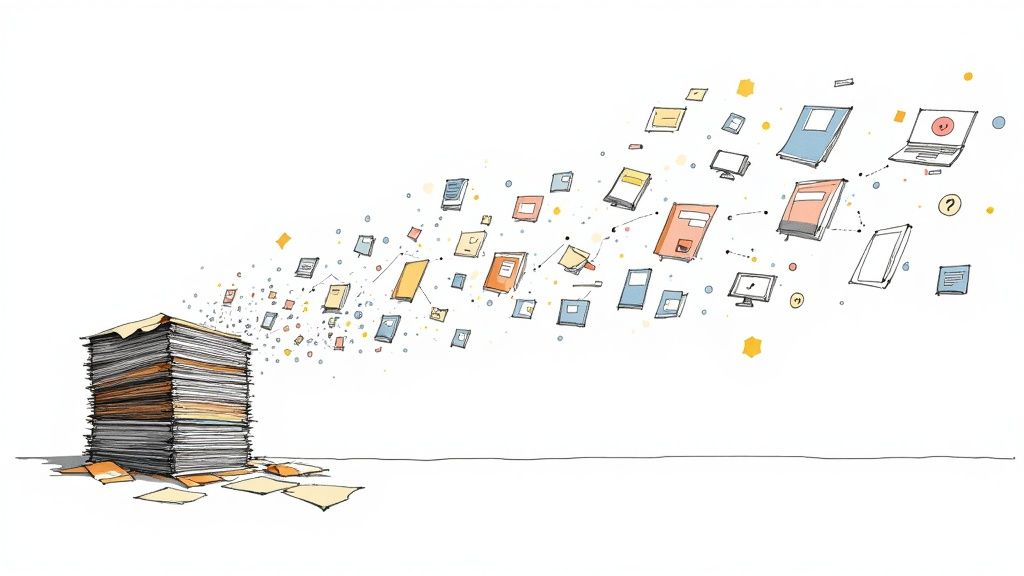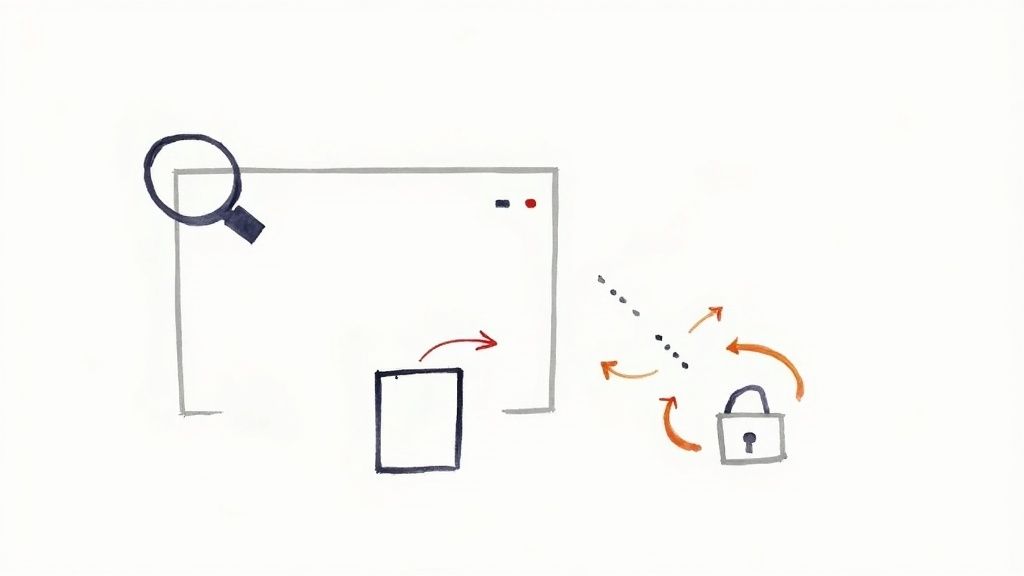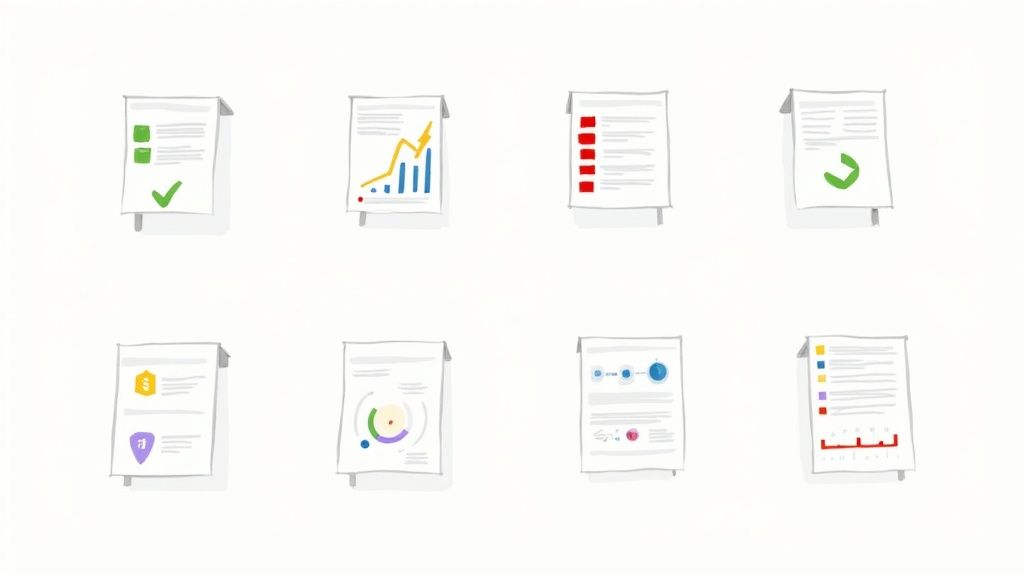
A paperless document management system (DMS) is, at its heart, a smart, digital filing cabinet built for your business. It’s a system designed to capture, store, and organize all your critical files electronically, making them secure and instantly available from anywhere. This isn't just about scanning paper; it's about fundamentally changing how your team finds information and gets work done.
Why Your Business Needs a Digital Filing Cabinet
Picture the typical office desk. For many, it’s a battleground of paper stacks, lost invoices, and filing cabinets that are bursting at the seams. Finding one specific contract can feel like an archaeological dig, burning through valuable time and causing a whole lot of frustration.
Now, contrast that with a clean dashboard where every single document is just a few keystrokes away. That’s the core promise of a paperless document management system. It’s so much more than just sticking scanned PDFs into a shared drive. A real DMS acts as a central hub that turns static files into active, intelligent assets for your entire company.
This shift is quickly becoming less of a choice and more of a necessity. It’s being pushed by the realities of remote work, the urgent need for better data security, and the simple, universal desire to work more efficiently.
Moving Beyond Outdated Methods
It's surprising how many businesses still lean on processes that are decades old. For instance, the healthcare's ongoing reliance on traditional fax is a perfect example of how outdated workflows can create bottlenecks. These old methods don't just slow things down; they clog up your entire operation, from bringing on new clients to closing out the books.
Breaking free from these physical chains opens up a world of possibilities:
- Instant Accessibility: Your team can pull up any file they need, whether they’re at their desk, working from home, or on the road. For example, a sales rep can access the latest pricing sheet from their tablet while in a client meeting, instead of relying on a potentially outdated printout.
- Enhanced Collaboration: Multiple people can view and even work on the same document at the same time without creating a confusing mess of V1, V2, and "Final_FINAL" versions.
- Improved Security: Digital systems come with powerful security features like access controls, encryption, and audit trails—a massive upgrade from a simple lock and key.
To give you a clearer picture, here’s an example of what a modern DMS dashboard might look like. This one was built with a no-code tool like Glide.
This kind of visual interface makes it easy to categorize documents, tag them with a status like "Approved" or "Pending," and find exactly what you need in seconds. It transforms a chaotic paper trail into a structured, manageable workflow.
The Growing Demand for Digital Systems
The global move toward digital documentation isn't just a fleeting trend—it's a massive market shift. The document management system market was recently valued at USD 8.96 billion and is on track to hit USD 10.15 billion in the next year alone.
This explosive growth, driven by a 13.3% compound annual growth rate (CAGR), shows just how many businesses are waking up to the incredible value of going paperless. If you're interested in the market dynamics, you can read the full research about DMS growth.
Ultimately, putting a paperless document management system in place is about future-proofing your business. It's a direct investment in your company's agility, security, and productivity—one that pays off by freeing your team from the dead weight of paper and empowering them to work smarter, not harder.
Core Features That Power Your Paperless Office

To really get why a paperless document management system is such a big deal, you have to look under the hood. It’s the specific features working together that turn a basic digital folder into a powerhouse for your business. These aren't just techy bullet points; they're the solutions to the daily headaches that slow you down.
Think of it like swapping a basic flip phone for a new smartphone. Sure, both make calls. But the smartphone’s features—the camera, GPS, and all the apps—totally change what you can do. A good DMS does the same for your documents, turning them from static files into active, valuable assets.
Let's break down the core features that make this happen, not as a dry list, but by looking at the real-world problems they solve.
Effortless Document Capture and Digitization
The first step in going paperless is simply getting your documents into the system. This feature, document capture, is your digital on-ramp. It’s much more than just scanning; it's about making both physical and digital documents instantly useful.
Picture your accounts payable team swamped by a mountain of paper invoices. With a DMS, they can use a high-speed scanner or even their phone to digitize them on the spot. The system’s Optical Character Recognition (OCR) technology then reads the text, making every single word searchable. Just like that, an invoice isn't just an image—it's a rich data file you can find in seconds by searching a vendor name, PO number, or date.
The same magic works on digital files. Instead of manually downloading and sorting email attachments, you can set up rules to automatically grab invoices from a specific supplier and file them away in your DMS, already tagged and ready to go.
Version Control That Ends the Filename Chaos
We’ve all seen it: a folder packed with files like "Proposal_v2," "Proposal_v3_final," and the dreaded "Proposal_FINAL_FINAL_USE-THIS-ONE.docx." This kind of mess isn't just confusing; it's risky. When people work from outdated versions, expensive mistakes are bound to happen.
Version control puts a stop to this chaos for good. It's like a time machine for your documents.
A DMS with version control ensures everyone is working from the single source of truth. It automatically tracks every change, creating a clear, accessible history of revisions without cluttering your folders with duplicate files.
If a colleague updates a contract, the system simply saves it as a new version. You can see who made the change, when they did it, and even roll back to a previous version if you need to. For collaborative work on legal agreements or project plans, this is absolutely essential.
Advanced Search That Finds a Needle in a Haystack
Finding one specific document in a traditional filing cabinet can take hours, if not days. Even basic digital folders aren't much help when you need to find something specific inside a document. This is where advanced search becomes a true game-changer.
Thanks to OCR, a good paperless document management system doesn’t just search filenames; it searches the full text of every single document in its library.
- Need to find a specific liability clause across thousands of client contracts? A quick search pulls up every relevant document in seconds.
- Trying to track down all invoices from one supplier over the last five years? Just filter your search by vendor and date range.
- Looking for a project brief from two years ago but only remember a key phrase? Type it in, and the system will pinpoint it for you.
This powerful capability transforms your archive from a "write-once, read-never" digital graveyard into a living, fully accessible knowledge base.
Seamless Integrations and Workflow Automation
A system that works alone is useful, but one that connects to your other tools is truly powerful. A modern paperless document management system is built to connect with the software you use every day, like SmartSuite, ClickUp, or Zapier. For businesses ready to go all-in on digital, checking out the top document automation software solutions is a crucial step for boosting efficiency.
These connections unlock powerful workflow automations.
- Example with Zapier: You could create a "Zap" that kicks off the moment a new client signs a proposal in DocuSign. From there, Zapier can automatically create a new client folder in your DMS, save the signed agreement, and then create a new task in ClickUp to get the project started.
This kind of automation gets rid of tedious manual tasks, cuts down on human error, and makes sure your processes are followed the same way, every single time. By digging into the possibilities, you'll find even more ways to connect your stack. For a deeper dive, check out our guide on 15 essential document automation features for businesses to see what else you can do.
The Real Business Impact of Going Paperless

Let's get real. A paperless document management system isn't just a fancy tech upgrade. It's a strategic move that directly impacts your bottom line. While the features sound great on paper (pun intended), the true magic happens when they translate into leaner operations, a more effective team, and seriously better data security.
This isn't just a niche trend; it's a massive market shift. The global market for paperless office systems was valued at USD 30.5 billion and is expected to climb to an impressive USD 62.4 billion by 2033. That kind of growth tells you something important: businesses are waking up to the power of efficiency and sustainability. You can see more data on the growth of the paperless office market on verifiedmarketreports.com.
But enough with the big numbers. Let's talk about what this looks like on the ground, in the real world.
Significant Financial Savings
The most immediate win you'll see is in your expense reports. The constant drain of buying paper, ink, toner, printers, and filing cabinets adds up fast. A paperless document management system just wipes those costs right off the budget.
And don't forget the hidden costs. That physical storage isn't free. Whether it's prime office real estate choked with filing cabinets or the monthly bill for an off-site storage unit, you're paying rent for paper. Going digital gives you that space back and cuts those recurring fees for good.
- Example: An Accounting FirmPicture an accounting firm buried in thousands of client tax forms and receipts each year. They're spending a fortune on paper and secure storage. By switching to a DMS, they slash printing costs and reclaim an entire room once dedicated to archives, turning it into a much-needed client meeting space.
Boosted Operational Efficiency
We all know time is money, and nothing wastes time like hunting for a physical document. A DMS makes finding information almost instant. Suddenly, workflows that used to crawl now fly. Your team can stop being paper detectives and start focusing on work that actually matters.
By centralizing documents and making them searchable, a paperless document management system removes the bottlenecks that slow down critical business processes. It's the difference between a five-minute search and a five-second click.
You'll feel this boost most in client-facing roles, where getting information quickly can make or break a deal.
- Example: A Marketing AgencyAn agency is kicking off a new project. The old way? The account manager hunts down the signed contract in sales, tracks down the client brief in another folder, and then waits for the creative team to find their initial mockups. With a DMS, all of those files live in one shared digital hub. A kickoff that used to take half a day of running around now happens in less than an hour.
Strengthened Security and Compliance
A locked filing cabinet provides a surprisingly weak sense of security. It's an easy target for theft and completely defenseless against fire or floods. A modern paperless document management system offers layers of digital protection that are far more robust.
Access controls let you decide exactly who can see, edit, or share any given document. This kind of granular control is absolutely essential for protecting sensitive data. Plus, audit trails create a perfect, unchangeable record of every action taken on a file, which makes accountability clear and compliance checks a breeze.
- Example: An HR DepartmentAn HR department handles incredibly sensitive employee files—personal data, performance reviews, salary info. With a DMS, the HR manager sets permissions so only specific people can even see these files. When an employee asks for their records, the system logs the access, fulfilling the request securely and leaving a transparent audit trail.
For businesses wanting to weave this security into their existing tools, it's smart to explore how document automation software can enforce these rules automatically.
Enhanced Team Collaboration
In today's world of remote and hybrid work, smooth collaboration isn't a "nice to have"—it's a must. Emailing attachments back and forth is a recipe for version-control chaos and siloed information. A DMS acts as a single source of truth, a central workspace where teams can write, edit, and review documents together in real-time.
- Example: A Remote Sales TeamA sales team is scattered across multiple time zones, all working on a critical proposal. Using their DMS, they all jump into the same document. One person updates the pricing, another polishes the project timeline, and every change is saved and tracked automatically. This lets them create a polished, accurate proposal in a fraction of the time it would've taken with the old email-and-pray method.
How to Implement Your Paperless System
Switching to a paperless document management system is more of a marathon than a sprint. But if you break the process down into clear, bite-sized stages, you can guide your office from being buried in paper to being digitally nimble—without causing a collective meltdown. This roadmap will walk you through the entire journey, from the first sketch to getting your whole team on board.
Think of it like building a house. You don't just show up one day and start nailing boards together. You begin with a detailed blueprint, pick the right materials, pour a solid foundation, and only then do you start framing the walls. Rolling out a new DMS works the same way; it's all about a structured, step-by-step approach.
Stage 1: Plan Your Digital Transformation
First things first: you need a plan. A solid implementation is built on a deep understanding of how things work now and a crystal-clear vision of where you want to go. This is your blueprinting phase.
Kick things off with a paper audit. Seriously, take a good, hard look at your current workflows. Where does paper actually come from in your business? How does it get passed between people and departments? Who touches it, and where does it go to die? Pinpoint the biggest logjams. Is it the clunky invoice approval process? The tedious client onboarding paperwork? Or the mess of managing contracts?
Once you have a handle on the current mess, you can set real, measurable goals. Don't just aim for a vague idea like "go paperless." Get specific. Your goals should sound more like this:
- Cut our invoice processing time by 50% within six months.
- Slash spending on paper and printing by 75% in the first year.
- Get all active client contracts stored and searchable in the new system by the end of this quarter.
Stage 2: Choose the Right Platform
With your blueprint and goals in hand, it's time to pick your tools. The market is packed with options, from turnkey Software-as-a-Service (SaaS) solutions to incredibly flexible platforms you can build on. Finding the right fit is a huge step, so it pays to research the best document management software and compare what's out there.
Your choice really hinges on your specific needs:
- SaaS Solutions like Noloco: These platforms are often good to go right out of the box. They come with pre-built features for document storage, sharing, and security, making them a great choice for businesses that want a fast, no-fuss setup without needing a developer on standby.
- Customizable Tools like Airtable or SmartSuite: These low-code/no-code powerhouses give you incredible freedom. You can construct a totally custom paperless document management system that fits your workflows like a glove, and even connect it to your other tools for a truly integrated setup.
For example, you could use Airtable to build a killer Digital Asset Management (DAM) system to keep everything from marketing photos to internal policy documents perfectly organized.
This Airtable view shows just how visual and intuitive it can be. You can track assets, see who owns what, and manage statuses—all from one clean, customizable dashboard.
Stage 3: Digitize and Organize Your Documents
Here comes the heavy lifting: turning all those paper files into digital ones. The key here is not to try and do it all at once—that’s a recipe for disaster. A phased approach is your friend.
Start with what's called a "day forward" strategy. Pick a date. From that day on, all new documents are born digital. This immediately stops the paper pile from getting any bigger. Then, you can start chipping away at the backlog of old files. Make sure to prioritize the documents you actually need to access regularly.
When you're scanning, using a tool with Optical Character Recognition (OCR) is absolutely non-negotiable. This tech is what turns a flat image of a document into searchable text. Suddenly, that static picture of a contract becomes a dynamic file where you can find any keyword or clause in seconds.
Once your documents are digital, they need a home. Design a logical folder structure that makes sense for your business (e.g., Clients > [Client Name] > Contracts). And please, use a consistent naming convention for your files (like YYYY-MM-DD_ClientName_InvoiceNumber.pdf). It’s a small thing that makes finding what you need infinitely easier.
Stage 4: Configure Your System and Pilot It
Now it’s time to actually build out the system. Set up your folder structure, but more importantly, configure your user permissions and access controls. This is a security must-do. Not everyone should see everything. The finance team has no business looking at HR performance reviews, and you definitely don't want a junior team member accidentally deleting a major client contract.
Before you unleash this new system on the whole company, run a pilot program. Pick a single department—maybe marketing or finance—and have them test-drive the system for a few weeks. This gives you a safe space to gather honest feedback, iron out any weird kinks, and polish your workflows. As a bonus, this pilot team becomes your new set of experts who can help train everyone else.
Stage 5: Drive Team Adoption and Manage Change
You can have the most brilliant paperless system in the world, but it's completely useless if nobody uses it. A successful rollout is just as much about people as it is about technology. This is all about change management.
Start by being really clear about the "why" behind the change. Explain the benefits, not just for the company's bottom line, but for them as individuals—less time wasted on filing, instant access to information, and easier ways to work together.
- Provide Real Training: Don't just email a link to a user guide and call it a day. Hold interactive, hands-on training sessions. Create quick reference guides and short video tutorials people can actually use.
- Lead by Example: Leadership has to be all in. When managers and executives are actively using the new DMS for their own work, it shows everyone that this is the new standard.
- Automate to Make It Easy: The new way has to be easier than the old way. For example, you can automate document generation to automatically create and file new reports or invoices. When you remove manual steps, adoption isn't just encouraged; it's a no-brainer.
Keeping Your Digital System Healthy for the Long Haul

Getting your paperless document management system up and running is a huge win, but the real work starts now. Think of it like a new car; it’s not enough to just buy it. You need to perform regular maintenance to keep that engine humming. Without a solid plan, your sleek digital office can quickly turn into a messy digital junkyard.
Long-term success boils down to having clear rules and consistent habits. This is what keeps your system organized and ready to scale as your business expands. It's about giving your digital files the same level of care you once gave to your most critical paper records.
Establish a Clear Governance Policy
The bedrock of any healthy paperless document management system is a solid governance policy. This is your official rulebook, dictating how every document lives—and eventually dies—within your organization. It covers everything from how you name a file to how long you keep it.
A good policy brings order to potential digital chaos. It should clearly outline:
- Document Creation and Naming: Set standards for how documents are created and what naming conventions to follow (e.g.,
YYYY-MM-DD_ClientName_DocumentType). Consistency is everything. - Access Control Tiers: Define who gets to see, edit, and delete different kinds of documents. Not everyone needs keys to the entire kingdom.
- Retention and Deletion Schedules: Spell out how long certain documents, like invoices or contracts, must be stored for legal or operational reasons, and when they should be securely destroyed.
A governance policy isn't a "set it and forget it" task. It's a living guide that stops your efficient new system from becoming a cluttered, ineffective mess over time.
For instance, a marketing team's policy might dictate that final campaign reports get tagged "Final Report" and archived after a year, while all draft versions are deleted after 30 days. This simple rule keeps their workspace tidy and focused on what matters.
Conduct Regular Audits and Plan for Disaster
Your system needs regular health checks. Running periodic audits ensures everyone is sticking to the governance policy and that you're staying compliant with any industry regulations. These check-ups are great for spotting security gaps, identifying training needs, or finding ways to make your workflows even better.
Just as crucial is having a disaster recovery plan. While digital systems are leagues safer than old-school filing cabinets, they aren't bulletproof. What’s your game plan if a server fails or data gets corrupted? A disaster recovery plan is your insurance policy, ensuring you can restore your information quickly and keep the lights on. This usually means setting up regular, automated backups to a secure, separate location.
Keep Your Team Trained and Secure
Technology changes, and so do the threats. The world's best security protocols are useless if your team doesn't understand or follow them. Continuous training is non-negotiable for reinforcing best practices and keeping everyone aware of new risks, like clever phishing emails or social engineering tactics.
Try scheduling short, mandatory security refreshers every six months. Keep them engaging with real-world examples of security breaches and emphasize the role each person plays in protecting the company’s digital assets. This is how you build a strong "human firewall."
Scale and Evolve with Integrations
Your business doesn’t stand still, and neither should your paperless document management system. The most powerful systems are built to grow with you, typically through integrations with the other tools you already use. This is where you connect your document workflows to the very pulse of your operations.
Project Management Integration: Hook up your DMS to a tool like ClickUp. Imagine an automation where creating a new project in ClickUp automatically generates all the necessary document templates—like kick-off checklists or client briefs—and files them in the right folder. It’s a huge time-saver that ensures consistency.
Custom API-Driven Workflows: For truly unique needs, a system with an API opens up a world of possibilities. You could build a custom workflow that pulls data from your accounting software, generates a polished PDF invoice, emails it, and archives a copy—all without a single human touch.
This shift toward strategic digital solutions is a massive business trend. The global document management market, valued at USD 7.68 billion, is expected to hit USD 18.17 billion by 2030. That's not just growth; it's a fundamental change in how business gets done. You can discover more insights about the DMS market's future and its impressive trajectory. By following these best practices, you’re making sure your paperless investment continues to pay off for years.
Common Questions About Paperless Document Systems

Making the leap to a paperless office is a big decision, and it’s completely normal to have questions. After all, you’re moving away from the physical files you know and trust to a digital environment. It can feel like a huge shift. To help clear up any hesitations, we’ve put together answers to the most common questions we hear from businesses considering a paperless document management system.
Think of this as your final check-in before starting your digital journey. We want to tackle those lingering concerns so you can move forward with confidence and a clear plan. Let's dive in.
How Secure Is a Cloud DMS Versus a Locked Filing Cabinet?
This is usually the first question people ask, and for good reason. A locked filing cabinet feels solid and secure—you can touch it, you can lock it. But in reality, its security is surprisingly fragile. It's vulnerable to physical theft, anyone with a key (or a crowbar) can get in, and it offers zero protection against disasters like fires or floods.
A modern, cloud-based paperless document management system provides layers of security that a metal box just can’t compete with.
- Granular Access Controls: You get to decide exactly who can view, edit, or share any given document. An HR manager, for instance, can lock down sensitive employee files so only authorized staff can even see that they exist.
- Encryption: Your data is scrambled both when it’s traveling to the server and while it's stored there. This makes the information completely unreadable to anyone without the right digital key.
- Audit Trails: Every single action—from a file being viewed to an edit being made—is logged. This creates a permanent, unchangeable record of who did what and when, which is absolutely vital for accountability and compliance.
While the idea of the "cloud" can feel abstract, the truth is that a reputable DMS offers far better security, control, and disaster recovery than a filing cabinet ever could. Your most critical information is already digital and stored on servers somewhere; the real question is how well you're securing it.
What’s the Most Efficient Way to Handle Our Backlog of Paper?
The image of digitizing mountains of old files can feel overwhelming. The key is to avoid trying to "boil the ocean." A strategic, phased approach is the only way to make it manageable without burning out your team.
Start with a "day-forward" rule. Pick a date, and from that day on, all new documents are digital from the start. This simple step immediately stops the paper pile from getting any bigger.
Next, prioritize your backlog. You probably don't need every utility bill from ten years ago. Focus on what actually matters:
- High-Priority: These are your active contracts, recent financial records, and essential legal or HR files that you access regularly.
- Medium-Priority: Think older but still relevant project files or client records.
- Low-Priority: This is archival material that you rarely, if ever, need to look at.
You can then scan these documents in batches, or even hand off the high-volume, low-priority stuff to a professional scanning service. This turns a monumental task into a series of achievable goals.
Is a Paperless System Affordable for a Small Business?
Absolutely. The old idea that a powerful paperless document management system is only for enterprise-level companies is completely outdated. Thanks to no-code and SaaS (Software-as-a-Service) platforms, these tools are more accessible and affordable than ever.
Many modern platforms, like Airtable or Noloco, work on a subscription model. This means you don't have to shell out a massive upfront investment for hardware or custom software. You just pay a predictable monthly or annual fee based on what you actually use.
Even better, these systems deliver major cost savings that often more than cover the subscription fee. You’ll spend less on paper, ink, toner, printers, and all that physical storage space. When you add up the time your team gets back from not having to hunt for documents, the return on investment becomes clear very, very quickly.
How Do These Systems Support E-Signatures and Legal Compliance?
Modern document management systems are built from the ground up with legal and regulatory needs in mind. Most platforms integrate directly with e-signature services like DocuSign or HelloSign, which means you can handle the entire lifecycle of a contract—from drafting to signing to archiving—all in one place.
For example, you can use a tool like Zapier to connect your DMS to your e-signature platform. When a client signs a proposal, Zapier can automatically file the legally binding, signed PDF into the correct client folder within your system. No more manual downloading and uploading.
When it comes to compliance, a DMS is your best friend. Features like version control, secure audit trails, and configurable document retention policies are designed to help you meet regulations like GDPR, HIPAA, or other industry standards. By automating these rules, the system helps ensure your business stays compliant without creating extra manual work for your team.
Ready to stop chasing paper and start building smarter workflows? DocsAutomator empowers you to turn data from tools like Airtable, Glide, and ClickUp into polished documents automatically. Generate invoices, reports, and proposals in minutes, not hours, and free up your team for work that truly matters. Start automating your documents for free with DocsAutomator.







